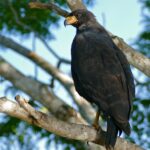The great black hawk (Buteogallus urubitinga) is a majestic bird of prey found in the tropical regions of the New World, ranging from Mexico to northern Argentina. While specific data on the lifespan of this species in the wild is limited, we can explore the available information to gain insights into the longevity of this remarkable raptor.
The Lifespan of the Great Black Hawk
The oldest recorded common black hawk, a close relative of the great black hawk, was at least 7 years old. However, the exact lifespan of the great black hawk in the wild is not readily available. This is due to the challenges of tracking and monitoring individual birds over their entire lifespans in the vast and often inaccessible habitats they inhabit.
Despite the lack of definitive data, we can make some educated estimates about the potential lifespan of the great black hawk based on the longevity of other raptor species. In general, birds of prey tend to have longer lifespans compared to smaller songbirds, with some species living well into their teens or even 20s in captivity.
Factors Influencing the Lifespan of the Great Black Hawk
 Image source: Great Black Hawk by Bernard DUPONT
Image source: Great Black Hawk by Bernard DUPONT
Several factors can influence the lifespan of the great black hawk, including:
-
Habitat and Environment: The great black hawk’s coastal and forested habitats in the tropics may provide a relatively stable and resource-rich environment, which can contribute to their longevity.
-
Predation and Threats: As a large and powerful raptor, the great black hawk has few natural predators, but it may face threats from human activities, such as habitat loss, hunting, and collisions with power lines or other infrastructure.
-
Diet and Nutrition: The great black hawk’s diverse diet, which includes reptiles, small mammals, crabs, and even fruits, may provide the necessary nutrients and energy to sustain a long lifespan.
-
Breeding and Reproductive Success: The great black hawk’s breeding and nesting behavior, including the construction of large stick nests in trees, may play a role in their overall health and longevity.
Unique Characteristics of the Great Black Hawk
The great black hawk is a distinctive and impressive bird, with several unique features that set it apart from other raptors:
- Size and Appearance: With a length of 56 to 64 centimeters (22 to 25 inches) and a weight of 1.1 kilograms (2 lb 7 oz), the great black hawk is a large and powerful bird of prey.
- Plumage: Adult great black hawks are predominantly black, with a short white-tipped tail and yellow legs and cere (the area around the bill). Immature birds have a more mottled appearance, with dark brown upper parts and buff-colored underparts.
- Feeding Behavior: The great black hawk is known to be a versatile and opportunistic feeder, preying on a wide range of small vertebrates, crabs, insects, and even scavenging on carrion and fruits.
- Nesting and Breeding: These birds build large stick nests in trees and typically lay a single dark-blotched whitish egg.
Sightings and Conservation Status
The great black hawk is a resident breeder throughout its range, but it can also be observed as a vagrant outside of its normal distribution. In 2018, a great black hawk was recorded in the ABA (American Birding Association) area, first on South Padre Island, Texas, and later in Biddeford, Maine, where it became a local celebrity before being rescued and ultimately euthanized due to frostbite.
Regarding the conservation status of the great black hawk, the International Union for Conservation of Nature (IUCN) currently lists the species as Least Concern, indicating that it is not considered to be at a high risk of extinction. However, ongoing monitoring and conservation efforts are essential to ensure the long-term survival of this magnificent raptor.
Conclusion
While the exact lifespan of the great black hawk in the wild remains elusive, the available information suggests that these birds can potentially live for several years, with the oldest recorded common black hawk reaching at least 7 years of age. The great black hawk’s unique characteristics, such as its impressive size, distinctive plumage, and diverse feeding habits, contribute to its ecological significance and make it a fascinating subject of study for birdwatchers and researchers alike.
As we continue to explore and understand the great black hawk, we can appreciate the remarkable adaptations and resilience of this species, and work towards ensuring its long-term conservation in the tropical regions it calls home.
References:
– https://www.allaboutbirds.org/guide/Common_Black_Hawk/overview
– https://en.wikipedia.org/wiki/Great_black_hawk
– https://www.birds-of-north-america.net/Great_Black_Hawk.html
– https://peregrinefund.org/explore-raptors-species/hawks/great-black-hawk
– https://animalia.bio/great-black-hawk


